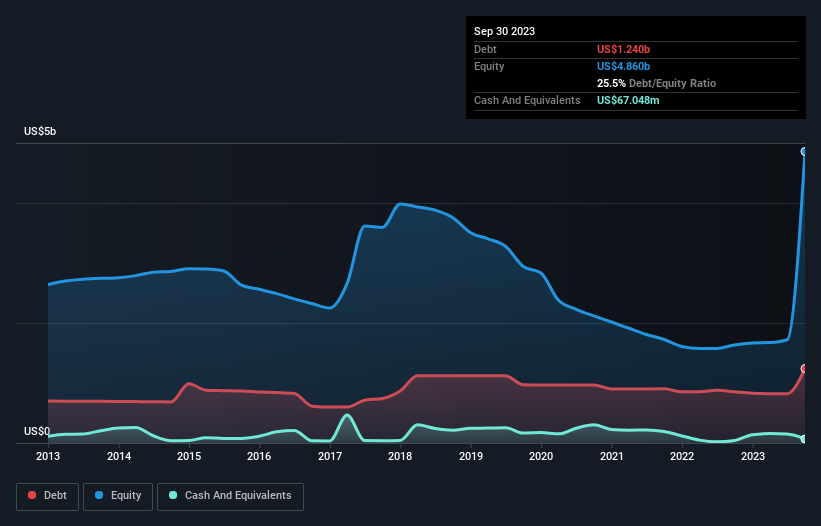- United States
- /
- Energy Services
- /
- NasdaqGS:PTEN
Here's Why Patterson-UTI Energy (NASDAQ:PTEN) Can Manage Its Debt Responsibly

Howard Marks put it nicely when he said that, rather than worrying about share price volatility, 'The possibility of permanent loss is the risk I worry about... and every practical investor I know worries about.' So it seems the smart money knows that debt - which is usually involved in bankruptcies - is a very important factor, when you assess how risky a company is. We note that Patterson-UTI Energy, Inc. (NASDAQ:PTEN) does have debt on its balance sheet. But should shareholders be worried about its use of debt?
Why Does Debt Bring Risk?
Debt assists a business until the business has trouble paying it off, either with new capital or with free cash flow. Part and parcel of capitalism is the process of 'creative destruction' where failed businesses are mercilessly liquidated by their bankers. However, a more frequent (but still costly) occurrence is where a company must issue shares at bargain-basement prices, permanently diluting shareholders, just to shore up its balance sheet. Of course, plenty of companies use debt to fund growth, without any negative consequences. The first step when considering a company's debt levels is to consider its cash and debt together.
View our latest analysis for Patterson-UTI Energy
How Much Debt Does Patterson-UTI Energy Carry?
As you can see below, at the end of September 2023, Patterson-UTI Energy had US$1.24b of debt, up from US$852.9m a year ago. Click the image for more detail. However, it does have US$67.0m in cash offsetting this, leading to net debt of about US$1.17b.

A Look At Patterson-UTI Energy's Liabilities
Zooming in on the latest balance sheet data, we can see that Patterson-UTI Energy had liabilities of US$1.04b due within 12 months and liabilities of US$1.52b due beyond that. On the other hand, it had cash of US$67.0m and US$1.05b worth of receivables due within a year. So its liabilities outweigh the sum of its cash and (near-term) receivables by US$1.44b.
This deficit isn't so bad because Patterson-UTI Energy is worth US$4.48b, and thus could probably raise enough capital to shore up its balance sheet, if the need arose. However, it is still worthwhile taking a close look at its ability to pay off debt.
We use two main ratios to inform us about debt levels relative to earnings. The first is net debt divided by earnings before interest, tax, depreciation, and amortization (EBITDA), while the second is how many times its earnings before interest and tax (EBIT) covers its interest expense (or its interest cover, for short). The advantage of this approach is that we take into account both the absolute quantum of debt (with net debt to EBITDA) and the actual interest expenses associated with that debt (with its interest cover ratio).
Patterson-UTI Energy has a low net debt to EBITDA ratio of only 1.2. And its EBIT easily covers its interest expense, being 11.3 times the size. So you could argue it is no more threatened by its debt than an elephant is by a mouse. Even more impressive was the fact that Patterson-UTI Energy grew its EBIT by 2,575% over twelve months. If maintained that growth will make the debt even more manageable in the years ahead. There's no doubt that we learn most about debt from the balance sheet. But ultimately the future profitability of the business will decide if Patterson-UTI Energy can strengthen its balance sheet over time. So if you're focused on the future you can check out this free report showing analyst profit forecasts.
But our final consideration is also important, because a company cannot pay debt with paper profits; it needs cold hard cash. So it's worth checking how much of that EBIT is backed by free cash flow. Over the most recent two years, Patterson-UTI Energy recorded free cash flow worth 55% of its EBIT, which is around normal, given free cash flow excludes interest and tax. This free cash flow puts the company in a good position to pay down debt, when appropriate.
Our View
Happily, Patterson-UTI Energy's impressive EBIT growth rate implies it has the upper hand on its debt. And the good news does not stop there, as its interest cover also supports that impression! Taking all this data into account, it seems to us that Patterson-UTI Energy takes a pretty sensible approach to debt. That means they are taking on a bit more risk, in the hope of boosting shareholder returns. The balance sheet is clearly the area to focus on when you are analysing debt. But ultimately, every company can contain risks that exist outside of the balance sheet. For example Patterson-UTI Energy has 3 warning signs (and 1 which is concerning) we think you should know about.
Of course, if you're the type of investor who prefers buying stocks without the burden of debt, then don't hesitate to discover our exclusive list of net cash growth stocks, today.
New: Manage All Your Stock Portfolios in One Place
We've created the ultimate portfolio companion for stock investors, and it's free.
• Connect an unlimited number of Portfolios and see your total in one currency
• Be alerted to new Warning Signs or Risks via email or mobile
• Track the Fair Value of your stocks
Have feedback on this article? Concerned about the content? Get in touch with us directly. Alternatively, email editorial-team (at) simplywallst.com.
This article by Simply Wall St is general in nature. We provide commentary based on historical data and analyst forecasts only using an unbiased methodology and our articles are not intended to be financial advice. It does not constitute a recommendation to buy or sell any stock, and does not take account of your objectives, or your financial situation. We aim to bring you long-term focused analysis driven by fundamental data. Note that our analysis may not factor in the latest price-sensitive company announcements or qualitative material. Simply Wall St has no position in any stocks mentioned.
About NasdaqGS:PTEN
Patterson-UTI Energy
Through its subsidiaries, engages in the provision of contract drilling services to oil and natural gas operators in the United States and internationally.
Very undervalued with adequate balance sheet.
Similar Companies
Market Insights
Community Narratives



